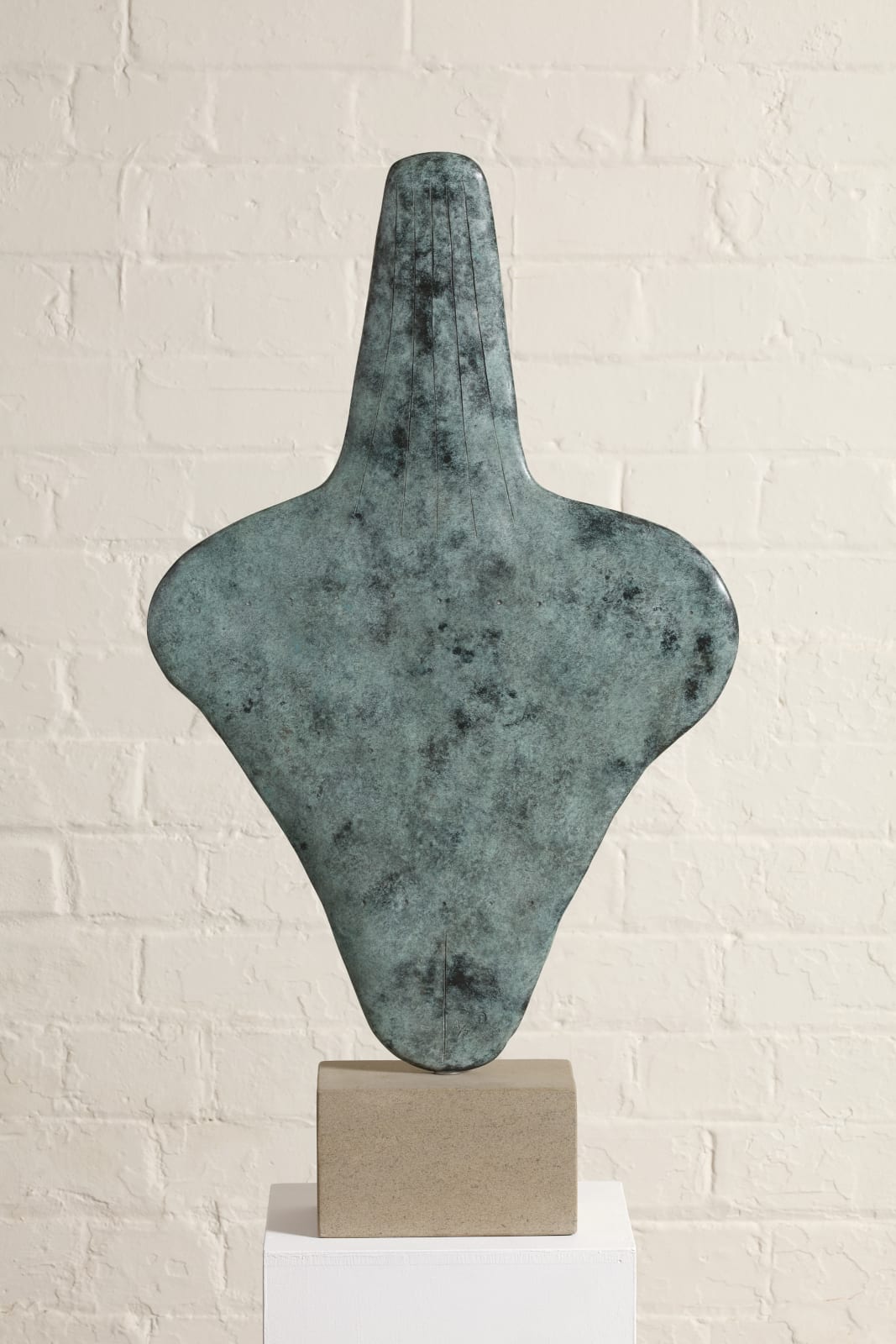William Turnbull 1922-2012
base: 3 3/4 x 7 1/2 x 5 in. (9.5 x 19.1 x 12.7 cm.)
Further images
Of the small number Turnbull elected to cast into bronze in 1979, three - Small Venus, Metamorphosis 1 and Arrowhead Torso (cat nos.188, 190, 192) - appear to have informed the sequence of sculptures which follow, all of which share the title Metamorphic Venus. This was the first figurative form Turnbull chose to work up into a large scale and the sculptures he made between 1981 and 82 form a sequence of mid-sized maquettes, each measuring somewhere between 52.4 cm and 63.5 cm (cat nos.206, 209, 210, 211, 212). Turnbull produced a human-scale version Large Metamorphic Venus in 1982 (h. 174.6 cm, cat no.221), and then, a year later, a final large version, Large Metamorphic Venus in 1983 (h. 152.4 cm, cat no.223).
Here, the flat, arrow-like shape, of Metamorphic Venus 3, 1982 has notable similarities to pre-historic tool forms. It also has echoes of the flat diamond-form of Ancient Egyptian schists and of Early Cycladic figurines, which have similarly wide-shouldered torsos and long thin noses. Turnbull was open about the diverse influences on his work and didn’t differentiate between high and low sources. He was a regular visitor to the British Museum and well versed in the museum’s collection, however he readily acknowledged that other sculptures had been variously inspired by his son’s skateboards and martial arts knives and the film star Marilyn Monroe, and that the shape and glow of cinema screens themselves had informed his ‘wide-screen’ canvases in the 1960s.
The reference to metamorphosis can be understood to refer to the process of making itself, as Turnbull translates objects into figures and figures to objects. Allusions to mythology are particularly apt given the Cycladic influence on the form, although of course Venus is the Roman version of the Greek Aphrodite. The most beautiful of all goddesses, she is said to have sprung forth from the waves of the sea - hence the Greek version of her name Aphrodite meaning literally ‘from the froth’ - a notion foregrounded here by the cast’s mottled sea-green patina.
That this is the goddess of love is conveyed in the smoothness of the surface and the figure’s exaggerated centre suggesting her youth and fertility. The surfaces of Turnbull’s bronzes in the early 1980s are much smoother than his roughly finished 1950s bronzes, which were scratched with deep lines or covered in a patchwork of grooves made with a comb. Here the overall surface is almost uniformly smooth, but still retains some sense that it has been worked by hand. The figure has a clearly defined nose, with fine, scored lines across what we might understand as her cheeks. There is the faintest suggestion of nipples and a tiny indentation to indicate the navel; her hands, pudenda, legs and feet are drawn in using the same fine lines as on the cheeks. On the back, more fine lines indicate her hair and legs and eleven indented marks span the width of the form.
The simplicity of the silhouette draws our attention to a certain organic quality in the surface and foregrounds the coloured patination, which varies widely across the edition. Amanda Davidson notes that in Metamorphic Venus 3 in particular, the smoothness of the form and its various coloured patinations - white, green and grey - mimic the appearance of marble, but that this notion then seems to be contradicted by its resemblance to an ancient bronze tool. While some of the forms in this series bulge out at the back, this version appears very thin when viewed from the side, like the silhouette of a ‘broad triangular leaf’1. She notes that across the series ‘The three aspects of the surface - the texture, markings and colour - combine to create ambiguous impressions of anonymous and personal creations; of works of great age, but with fresh finishes; of primitive and modern cultures; of artificial and natural conjunctions; of texts with potential meanings but without any clues or contexts to break the codes; and of stately and quiet sculptures but with surfaces of great movement, energy and beauty’.2
Turnbull’s figure forms present a sense of containment and silence, which is enhanced by their gentle symmetry. In his introduction to Turnbull’s 1996 Serpentine Gallery retrospective, David Sylvester notes the hieratic quality of these works. While this word, he explains, is ‘often used to designate any frontal, symmetrical, compact, simplified, static image with a somewhat autocratic look’, he notes its original meaning, as a description of something that is ‘priestly’. Citing the myriad points of reference in Turnbull’s oeuvre to artefacts which are ritualistic or devotional in nature, Sylvester finds ‘a quality in some of Turnbull’s figures, which creates an expectation that, if some of them were to be placed in a simple well-lit building, it would become a temple’.3
1 Amanda A. Davidson, The Sculpture of William Turnbull, Henry Moore Foundation and Lund Humphries, London, 2005, p68
2 Ibid
3 David Sylvester, William Turnbull, Sculpture and Paintings, 1995-6, Serpentine Gallery, London, p9
Provenance
Barbara Mathes Gallery, New YorkPrivate Collection, USA, acquired from the above in 2002
Exhibitions
London, Waddington Galleries, William Turnbull: Horses - Development of a Theme, Other Sculptures and Paintings, 22 June- 20 July 2001, cat no.13, illus colour, pp28-29 (another cast)
London, Connaught Brown, Henry Moore: Influences and Influenced, 3 May - 15 June 2019, (this cast)
Literature
Amanda A. Davidson, The Sculpture of William Turnbull, Henry Moore Foundation and Lund Humphries, London, 2005, p68, cat no.211, illus b/w p156





